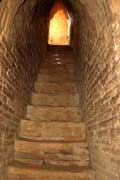 |
| 1. Temple entrance
|
|
 |
 |
| 2. Horse cart
|
|
 |
 |
| 3. Young monks
|
|
 |
 |
| 4. Staircase
|
|
— Index —
|
 |
|
 |
The archaeological site at Bagan is certainly the reason that most tourists come to Myanmar. It does not disappoint. There were once as many as 13,000 temples and pagodas here, in an area of about 100 square kilometers on the banks of the Irrawaddy River. Today, most are in ruins; many are no more than a pile of broken bricks. But over 2,000 remain, either intact or restored (see photo #1, at left). The Bagan plain is literally studded with temples (see the panorama, above). These structures were all built during the 11th, 12th, and 13th centuries. Built of brick in a seismically active area, it is surprising that any remain at all.
Although this is still a rural farming area, and there are still relatively few tourists who visit Myanmar, tourism has become a major source of income for the Bagan area. There are dozens of guest houses, restaurants, and hotels, particularly in the nearby village of Nyaung U. Many of the local people have taken to providing tourist services, including the many horse carts that are used for local transport (photo #2). Many talented artists paint copies of the decorations inside the temples onto cotton cloth, and offer them for sale. We purchased a painting of the Buddha images that decorate the ceiling of an arch in one of the smaller temples. We stood under the arch and compared the artist's work with the original. He did a great job.
Many buildings are either ruins, or recently restored. Others remain in active use by both monks (photo #3) and Buddhist pilgrims. These temples and pagodas are the most interesting, as they approximate the condition they would have been in originally. In many places, only the basic brick structure remains, with no indication of the beautifully detailed plaster that would have covered the original building. We explored many small temples without names that still contained lovely Buddha images and other artwork. In the following pages, we will attempt to give you an idea of the beauty of this wonderful, ancient place, and of the people who live and work near here.
The best views of Bagan are from the tops of the temples. However, the government has begun restricting access to many of the temple roofs. The stated reason is to protect the buildings from damage. In addition, the stairs are narrow and steep (photo #4), the steps are often uneven or damaged, and the passages are often dark. Once on the top, there are no guardrails to keep one from falling off. For whatever reasons, the government has begun construction of a new tourist center that will include a tower to provide clear views of the area. Once the tower is completed, the roofs of all of the temples and pagodas will likely be closed to visitors.
Our Bagan story continues with two pages of temple information and photos, and the etc. page which includes some arts & crafts and miscellaneous photos. Use the links in the index (left) or at the top of the page to see everything.
— return to the 2004 Journal Archive
|